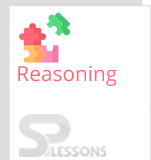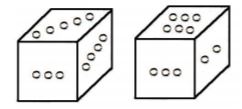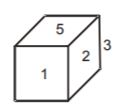 Introduction
Introduction
Logical Reasoning is an important section in the competitive exams throughout the globe. Logical reasoning is primarily designed to test the aptitude skills of the candidates taking the exams. Cubes and Dice related questions are frequently seen in several competitive exams including recruitment exams in India such as SSC CGL, Banking, Railways, and other exams such as CAT, GRE, GMAT, etc. The article Cubes and Dice Practice Quiz lists some practice questions that will apply different concepts of cubes and dice.
What is a Dice? A Dice is a Cube. A cube has 6 squares faces/sides and 8 vertices/corners, and 12 edges. Only 3 sides of a cube are visible at any given time. These sides are known as adjacent sides and can never be to the opposite side of each other. A Dice usually has numbers labelled 1 to 6.
 Quiz
Quiz
Directions: (1 – 5)
A cube is colored red on one face, green on the opposite face, yellow on another face and blue on a face adjacent to the yellow face. The other two faces are left uncolored. It is then cut into 125 smaller cubes of equal size.
Answer the following questions based on the above statement
1. How many cubes are uncolored on all the faces?
- A. 27
B. 36
C. 48
D. 64
- A. 8
B. 12
C. 16
D. 23
- A. 8
B. 10
C. 12
D. 16
- A. 4
B. 5
C. 16
D. 25
- A. 23
B. 21
C. 20
D. 19
- A. 4
B. 3
C. 2
D. 5
- A. 1, 2, 5
B. 3, 4, 6
C. 1, 2, 6
D. 2, 3, 5
- A. 3
B. 1
C. 9
D. 6
Directions: (1 – 2)
Six sides of a cube are coloured with different colours. Yellow is opposite white and blue is between red and green. One side is black.
1. Which colour is opposite blue ?
- A. red
B. black
C. green
D. None of these
- A. green
B. yellow
C. white
D. blue
- A. 8
B. 16
C. 36
D. 54
- A. 8
B. 16
C. 36
D. 54
- (i) A rectangular wooden block is having lenght 6 cm, breadth 4 cm and height 1 cm.
(ii) Both sides having dimension 4 cm × 1 cm are painted with black colour.
(iii)Both sides having dimension 6 cm × 1 cm are painted in red colour.
(iv)Both sides with dimension 6 cm × 4 cm are painted in green colour.
(v) The block is cut into six equal pairs of 1 cm each (from 6 cm side) and into 4 equal parts of 1 cm each (from 4 cm side).
- A. 6
B. 12
C. 10
D. None of these
- A. 6
B. 12
C. 16
D. 24 of these
- A. 4
B. 8
C. 12
D. None of these
- A. 12
B. 10
C. 8
D. 4
- A. 8
B. 4
C. 16
D. 10
Directions: (1 – 5)
Six dices with their top faces erased have been given. The opposite faces of the dices have dots which add up to thirteen. Work out the number of dots on the top faces, according to the question spot your answer from among-st the given alternatives
1. If the odd numbered dices have even number of dots at their bottom faces, what would be the total number of dots?
- A. 20
B. 22
C. 24
D. 18
- A. 15
B. 18
C. 21
D. 17
- A. 19
B. 18
C. 17
D. 16
- A. 8
B. 4
C. 0
D. 1
- A. 18
B. 20
C. 16
D. 24







